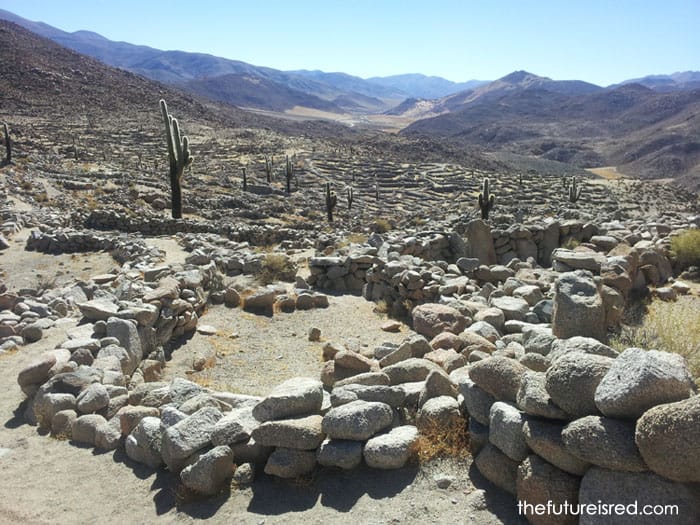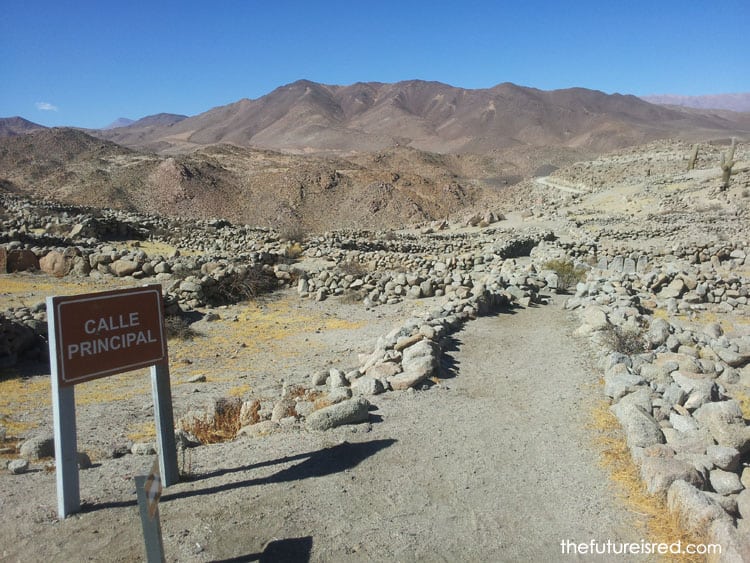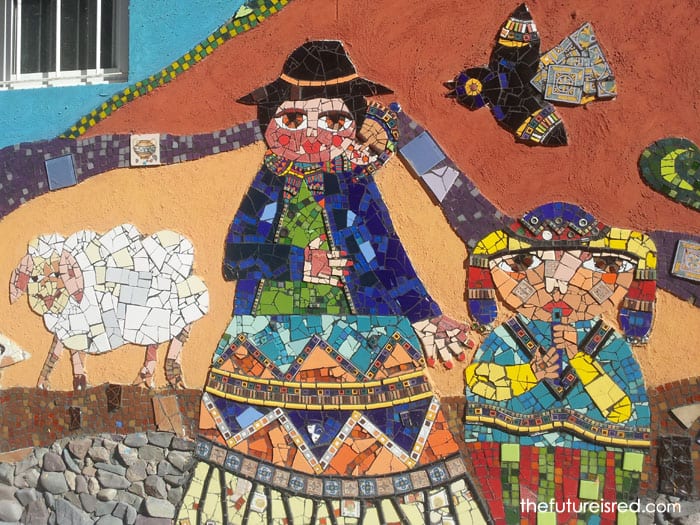I hadn’t intended to write about this, but then our day trip was just so lovely, I had to write.
We left Sunday morning later than planned. Always running late. Then I reminded myself. It’s Sunday. There’s no such thing as late on a Sunday morning especially when you live in Argentina. So we drove south from Salta toward Campo Quijano. From there, we followed the dirt road going up, up, up into the mountains, following the tracks of the Tren a las Nubes along the Quebrada del Toro through dry mountains and past the tiny town of Alfarcito to Santa Rosa de Tastil.
The trip takes about an hour and a half, but that really depends how comfortable you are driving fast along the sinuous roads. You share the thin road beside oft steep drop offs with trucks, donkeys, not too many people. There is no cell reception. You will want to stop for photos. Many of them. Often.
Geology and time pressed seven different colors of sand into mountain ranges. Blue sky frames the mountain, not just one blue but a gradient of sky blue in the foreground running to powder and indigo and finally azure as far back as the eye can ponder. Not a cloud in that sky. Or maybe sometimes one shapely little puff to make it perfect.
Along the mountain silhouette cactuses waved their arms to catch my attention. I kept mistaking them for people as they stretched their arms to the sky or reached out in an embrace. I caught a Shiva cactus, limbs undulating in all directions, spying down on us from his heights. “Just one more photo. No, now I mean it. Just one more.” Finally, I had to accept that there will never be enough one mores.
Santa Rosa de Tastil. Oh what a tiny but lovely town. The sun glared down from above, heating the car to a deceptive sweltering, because outside it was cool. We needed sweaters. Luckily, you can buy llama sweaters and ponchos of any colors and for all body shapes and sizes right in the center of town. Yes, they’re the standard tourist sweaters you can find in any mercado from here to Tucuman, but when you’re cold, you’re thankful for a tourist trap.
Yes, it’s a lovely, tiny town with one hundred inhabitants and two restaurants, one closed. We asked for the other and were pointed in the direction the main, really the only street in town. We opened a rather nondescript door, and once my eyes accustomed to the dark after the bright, bright outdoors, I saw four tables with chairs and a kiosko selling cookies, gaseosas and chips.
Don’t ask for a menu. There is only what they have cooking in the back. That day? Empanadas, only eight still available and plates of mondogo, tripe stew with potatoes and carrots. In these parts, the empanadas are fritas and only the meat variety. Sometimes no-choice is just as good as choice. We ate our lunch in the cool and empty, shadowy dining room.
There’s a left turn just past Santa Rosa. Not too far, you could even walk it. After the turn, you ascend. The road to Tastil twists sharply left and then back right for perhaps a mile before reaching the ruins at the top. How windy was the day we visited? Windy enough to push the car door closed before I wanted to close it. Windy enough to shove me forward then back but not off the mountain. I wonder if anyone ever flew from these heights during a particularly strong storm.
There at the top lies a well tended archeological site with placards of maps and information. Two routes lead you through the ruins. One short walk. One slightly longer. Both well marked with arrowed signs. And there, curving out toward the horizon lie the ruins of Tastil.
We looked down into the valley where where the pre-Incan Atacameño people sowed and harvested quinoa and corn. They ate llama meat. For water, they tapped into Rio Toro that winds through this region, creating a watery oasis for them to drink and nourish their crops. Thus, people gathered and thrived.
We walk through the ruins, following the arrows past the view of fields where they grew their food, past the tomb of the cacique, the village leader and then down main street and the plaza principal before heading back up the mountain to the parking lot.
“What happened to the people here?” Lila asked. Maybe the water ran out. Maybe the Incans destroyed them as they did so many of the pre-Incan people in northern Argentina leaving only the broken walls, open streets and the reaching arms of cacti that have been growing since the community disappeared six hundred years ago. They were once three thousand people on this mountain, all gone. All died and made way for another group of people.
I took more photos. One cactus stands impossibly tall. Another, fell, lies down with arms folded. It looks as if it’s sleeping. I imagine they’re human, soft and pleasantly fleshy to the touch.
On the way home Lila pipes up “Mom… Dad… When our dogs die…” Noah and I immediately erupted into laughter at the joke. His grandmother, a wonderful, sometimes horrible and cutting, but ballsy-as-hell woman kept us continually aware of the lifespan of our pets.
“Grandma Ruth, Grandma Ruth, we just got a puppy!”
“How long’s that thing going to live?”
I was still smiling when I realized once again how much I miss her.
Lila finished her question.“When our dogs die, can we dig a hole and bury them in the back yard.”
“I say we build a massive funeral pyre and spread their ashes in the mountains,” added Noah.
“If we bury one, the survivors will probably dig him up.” Then the conversation devolved into which dog would die first and which would dig, but Lila persisted.
“We could dig a very, very deep hole?”
“Do you have any idea hard the ground is?”
I understand Lila’s reasoning. She loves her dogs. She wants to be near them always. I won’t tell her that even if we bury them in the back yard, there are no guarantees we’ll always be there to guard them. The world is so big, and life so short. Yes, I love it here, but I don’t want to stay forever.
On the way home, we stopped in Alfarcito, another mountain town where the children of the local villages attend classes. We took pictures of the striking mosaics covering the schoolhouse. We stopped again to see the bright green cypress and willow trees growing in the wet spots between a parched mountain on either side. We stopped one last time to buy strawberries on the road beside Campo Quijano.
They were beautiful, those strawberries, and sweet. I bought a kilo, and we ate them for dinner as the sun set on that lovely day with not a cloud in the sky except one that is just there to remind you of our picture perfect Sunday.





